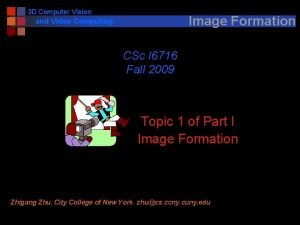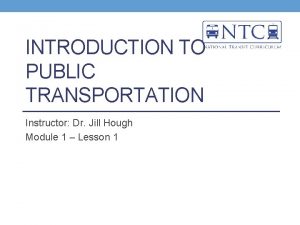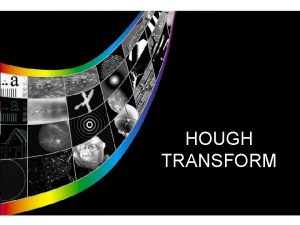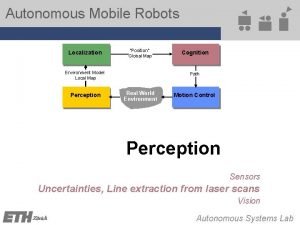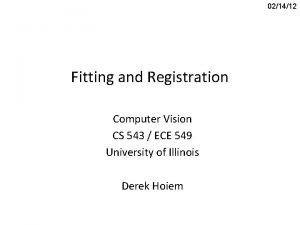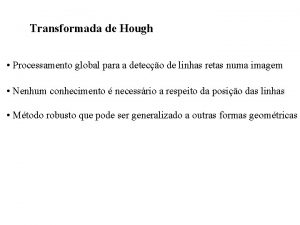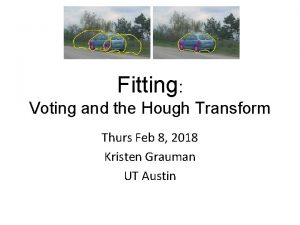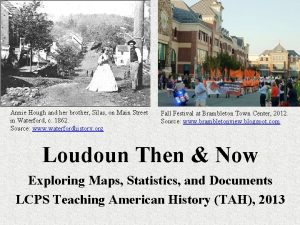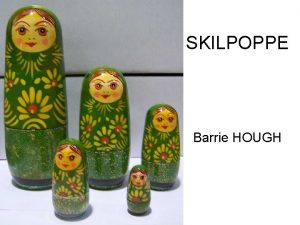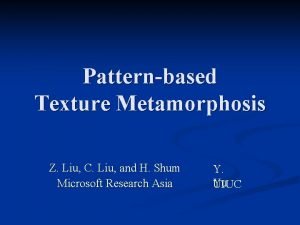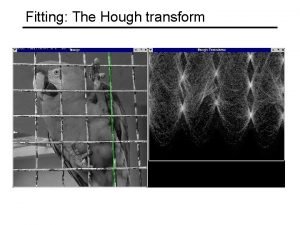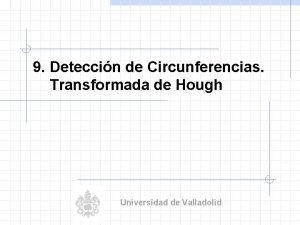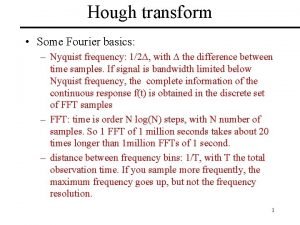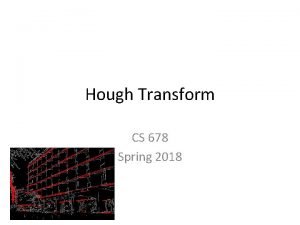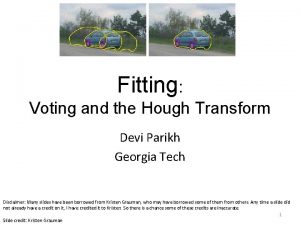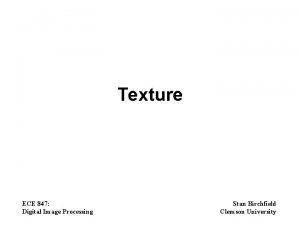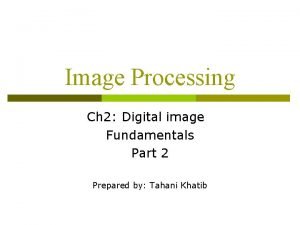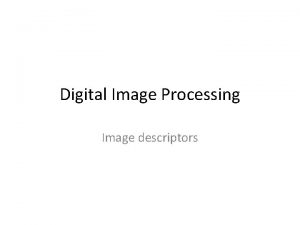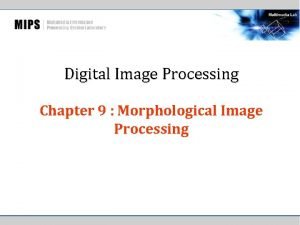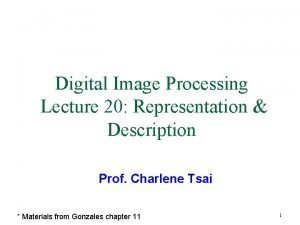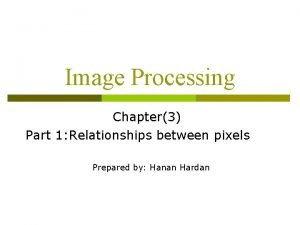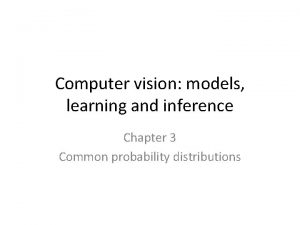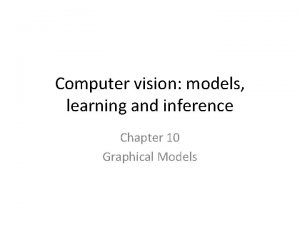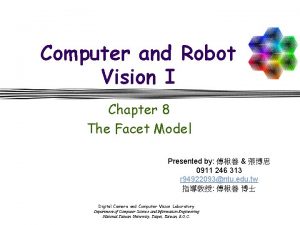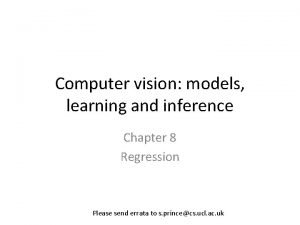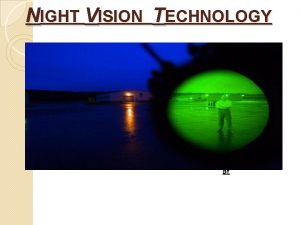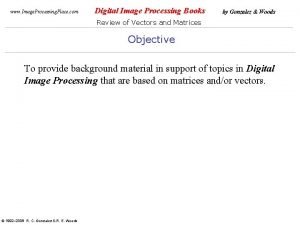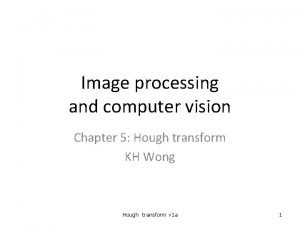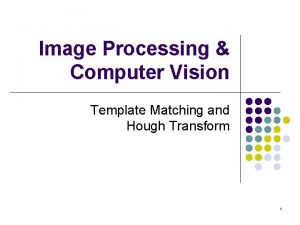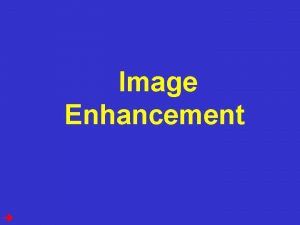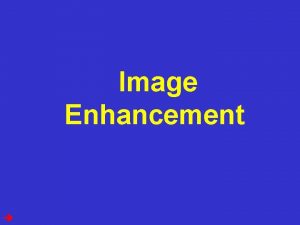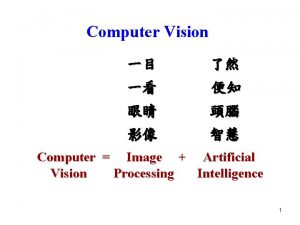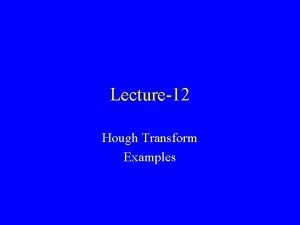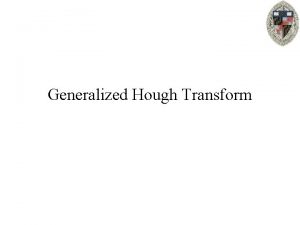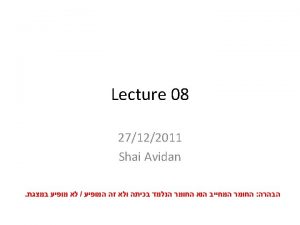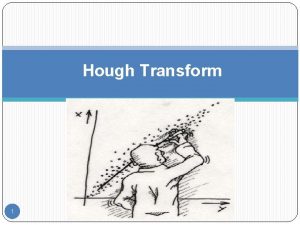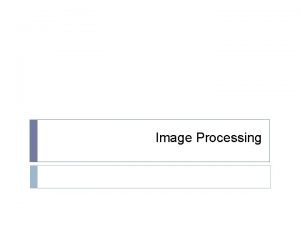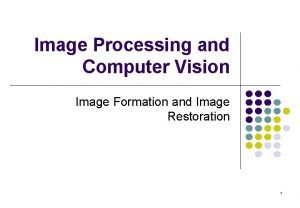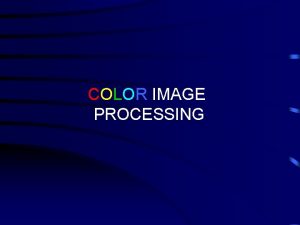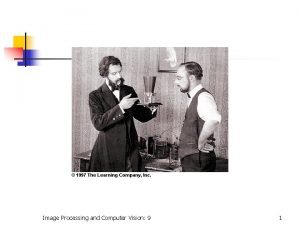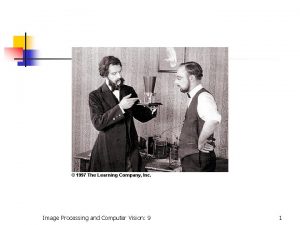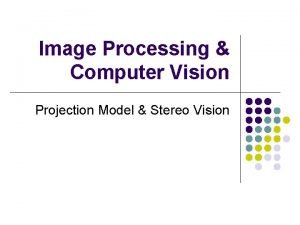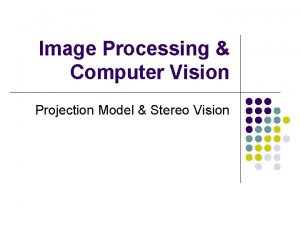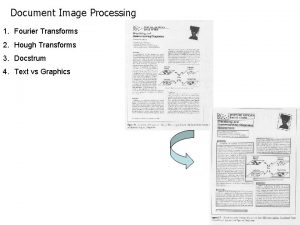Image processing and computer vision Chapter 5 Hough


































































- Slides: 66

Image processing and computer vision Chapter 5: Hough transform KH Wong Hough transform v 1 a 1

Introduction | Line detection | circle detection | irregular shape detection Overview • What is the problem? – A method to fit a line for a set of features. • Why traditional methods are poor? – Need a different formulation for different line types (i. e. , line, curve, circle…) • How to do it? – We will discuss the basic algorithm for lines, circles, ellipse. • We will extend it to any line types. – Using the Generalized Hough transform • Ref – http: //en. wikipedia. org/wiki/Hough_transform – Lecture notes by Instructor: S. Narasimhan Hough transform v 1 a 2

Introduction | Line detection | circle detection | irregular shape detection The problem • Fit a curve , line, circle or ellipse to a set of edge points. • Traditional method – Energy minimization by Calculus. Features are found by edge detection • Fit a curve, a circle, an ellipse or a line which has minimum distances from the edges. Hough transform v 1 a 3

Introduction | Line detection | circle detection | irregular shape detection Least Squares energy minimization (see http: //mathworld. wolfram. com/Least. Squares. Fitting. html) Given: Many pairs Find: Parameters Minimize: Average square distance: Using: Note: Hough transform v 1 a 4

Introduction | Line detection | circle detection | irregular shape detection Curve Fitting Find Polynomial: that best fits the given points Minimize: Using: Note: is LINEAR in the parameters (a, b, c, d) Hough transform v 1 a 5

Introduction | Line detection | circle detection | irregular shape detection Line detection using Hough transform For straight line detection (a very efficient method) Hough transform v 1 a 6

Introduction | Line detection | circle detection | irregular shape detection Reason to use Hough transform • Why the previous energy minimization method is too complicated? Because: – Different formulations for different types (line, circle, ellipse etc. ) – Hough is the same method for all types. – Hough transform is more suitable for computers. Hough transform v 1 a 7

Introduction | Line detection | circle detection | irregular shape detection Example • To find the line (y=mx+c) – y=-2 x+10 – m=-2, c=10 • Assume you don’t know the line formula – But have three points passing through the line y – X=1, y=8 (1, 8) Line (2, 6) – X=2, y=6 y=mx+c (3, 4) – X=3, y=4 x Hough transform v 1 a 8

Introduction | Line detection | circle detection | irregular shape detection Change of variables (x, y) (m, c) • • • y=mx+c m=(y-c)/x m=(-1/x)c+y/x m=G*c+D, where G=-1/x, D=y/x Procedure: find (m, c) from points (xi, yi) – 1)Find the line for (m, c) as variables (not x, y as variables) – 2)For each point (xi, yi), plot line in (m, c) space • Give a range of m values (e. g -10, 0, 10. etc, at least 2 values) • Find c value for each m value, plot line – 3) The cutting point of lines in m-c space is the solution for (m, c) Hough transform v 1 a 9

Introduction | Line detection | circle detection | irregular shape detection Exercise 1 : Derivation exercise • Exercise 1: y=px+q, where p is the gradient of the line, q is the vertical-axis cutting point. Rearrange the equation in p, q space. I. e. p=(U)q+(V). Find U, V in terms of x, y • Answer: Hough transform v 1 a 10

Introduction | Line detection | circle detection | irregular shape detection Example 1 y=mx+c , (original) m=(y-c)/x m=(-1/x)c+y/x Procedures 1) m=G*c+D, where G=1/x, D=y/x 2) plot lines in (m, c) space (x, y) points G=(-1/xi), D= (yi/xi) For (x 1, y 1)=(1, 8), G=-(1/1), D=(8/1) So m=G*c+D=>m=-c+8 m m=-2, c (=10 found) m=0, c (=8 found) m=10, c (=-2 found): blue line c Cutting point of the 3 lines: (m, c)=(-2, 10) So the line is y=-2 x+10 (done!) Repeat for (xi, yi)=(2, 6) and (3, 4). Each point (xi, yi) gives a line Cutting point in (m, c) space is the solution. (m, c)=(-2, 10) y=-2 x+10 Hough transform v 1 a 11

Introduction | Line detection | circle detection | irregular shape detection Exercise 2, Excel example • Given 3 points find the line formula • • • – X=1, y=9 – X=3, y=15 – X=5, y=21 y=mx+c , (original), Now in m, c space m=(y-c)/x m=(-1/x)c+y/x Procedures 1) m=G*c+D, where G=-1/x, D=y/x 2) plot lines in (m, c) space Their corresponding points lines in (m, c) space: Give 3 values of m find values in c, plot line – m=(-1/xi)*c+(yi/xi) – For (x 1, y 1)=(1, 9), – G=-(1/1), D=(9/1) – So m=G*c+D=>m=-c+9 • m=-10, c ? ____ • m=10, c ? ____ – Repeat for (xi, yi)=(3, 15) and (5, 21). – Each point (xi, yi) gives a line • Cutting point in (m, c) space is the solution. Hough transform v 1 a 12

Introduction | Line detection | circle detection | irregular shape detection Reason to use polar coordinates • Why the previous method (x, y) space to (m, c) space is still not ideal? Because: – Different formulations for different types (line, circle, ellipse etc): For straight lines (m, c) space is ok but not extendable, so use polar coordinates (r, ) space for lines, circle or ellipse. • Hough transform is very suitable for computer implementation. Hough transform v 1 a 13

Introduction | Line detection | circle detection | irregular shape detection How to apply Hough transform to line detection using polar coordinates (r, ) space. It is easily extendable to circle and ellipse • A line can be represented in this way. y =Edge point • r x Hough transform v 1 a 14

Introduction | Line detection | circle detection | irregular shape detection Representation changes from (x, y) to (r, ) space • • A test line can be represented by – r (Dist)= the perpendicular line from origin to the test line – (Angle)= between the perpendicular line and the horizontal axis Note: =Edge point y Perpendicular Line of the test line r Test line Hough transform v 1 a x 15

Introduction | Line detection | circle detection | irregular shape detection Exercise 3 • • (0, y”) y =(0, c) Perpendicular Line of the test line =Edge point Test line r x (x”, 0) Hough transform v 1 a 16

Introduction | Line detection | circle detection | irregular shape detection Example • To find the line – y=-2 x+10 – m=-2, c=10 • Assume you don’t know the line formula – But have three points on the line – X=1, y=8 – X=2, y=6 – X=3, y=4 Hough transform v 1 a 17

Introduction | Line detection | circle detection | irregular shape detection Hough line detection (e. g a 3 edge point example) • We have 3 points (x, y)= (1, 8), (2, 6), (3, 4). • r=sin( )*yi+cos( )*xi • concentrate on the first point (xi, yi)=(1, 8). – Create a test line table ( =0, 30, 60 , . . ) of lines that pass thru. (xi, yi)=(1, 8) – Plot vs r y Test lines for (1, 8) using Different (0 o, 30 o, 60 o…) (1, 8) (2, 6) r=4. 87 (3, 4) =30 • x Fixed x=1, y=8, find r of different • Repeat above steps for the points (2, 6), (3, 4). (xi, yi)=(1, 8), if =30, so r=sin(30*pi/180)*yi+cos(30*pi/180)*xi r=sin(30*pi/180)*8+cos(30*pi/180)*1=4. 87 18 Hough transform v 1 a

Introduction | Line detection | circle detection | irregular shape detection Exercise 4: Hough line detection (e. g a 3 edge point example) y • We have 3 points (1, 8), (2, 6), (3, 4). • concentrate on point (2, 6). – Create a test line table ( =0, 30, 60 , . . ) of lines that pass (2, 6) – Plot vs r (1, 8) (2, 6) R=4. 87 • Formula • (3, 4) =30 x =SIN($A 4*PI()/180) *B$2+COS($A 4*PI()/180)*B$1 Answer: fill in the Repeat above steps for the points r column: (3, 4). • • Test lines for (2, 6) Hough transform v 1 a 19

Introduction | Line detection | circle detection | irregular shape detection 3 points 3 curves Theta= • Formula “=SIN($A 4*PI()/180) *B$2+COS($A 4*PI()/180)*B$1” • Solution: the intersecting point= (r, )=(4. 5, 27 o) • To verify: m=-cos( )/sin( )=-1. 96, C=r/sin( )=9. 9 • Done, real answer is y=-2 x+10, m=-2, c=10 (Hough method produces a Hough transform v 1 a solution close enough to the real answer) 20

Introduction | Line detection | circle detection | irregular shape detection Algorithm for computation • Objective: Given N edge points (xi, yi) for i=1, …N find ( , r) • • Create a 2 -D array of ( , r), initialized with zeros For i=1, …N { For j=1, 2, . . , 360 (i. e. using 1 degree resolution) { – Find rj using the above formula – Increment once the cell with indexes close to j and rj • • } } The cell in the ( , r) array with the biggest value is the solution. Accuracy depends on how many memory cells you used Hough transform v 1 a • 21

Introduction | Line detection | circle detection | irregular shape detection Hough Transform Demo • Demos From http: //www. dis. uniroma 1. it/~iocchi/slides/icra 2001/java/hough. html http: //www. activovision. com/octavi/doku. php? id=hough_transform https: //www. youtube. com/watch? v=ebfi 7 q. OFLuo If points are not exactly lying on the same line (noise effect), the curves may not collide at a single point. Solution: take approximation. Hough transform v 1 a 22

Introduction | Line detection | circle detection | irregular shape detection Exercise 5 • • Create the Angle-Distance (r, ) table for the edge point (x, y)=(0, 3). The step length of the angle is 45 degrees. (Angle= ) Use =SIN($A 7*PI()/180) *B$2+COS($A 7*PI()/180)* B$1 Fill in the r-column: • In radian= ( /180)*angles_in_degree Try Google “=sin(45)” Hough transform v 1 a • 23

Introduction | Line detection | circle detection | irregular shape detection Circle detection using Hough transform Reference Course notes by Sumit Tandon : # EE 6358 Computer Vision, University of Texas at Arlington Hough transform v 1 a 24

Introduction | Line detection | circle detection | irregular shape detection Circle Detection • A circle that first the give edges xi, yi (i=1, . . N) is • We need to find the center (xc, yc) and radius (r ) • Each edge point gives a cone (if r is not fixed, if r is fixed they are circles on a plane) at different locations in Hough space • The intersection of all these cones is the solution. for xc, yc, r. Hough transform v 1 a 25

Introduction | Line detection | circle detection | irregular shape detection To show the basic concept If r is known, it is a 2 D problem: circles on a plane • Circle: Assume the radius r is known, each point on circle of the (x, y) space will form a circle in the (Xc, Yc) circle-enter-space yi Accumulator Array (xc, yc) (xi, yi) r yc Each edge point becomes a circle solution xc xc xi Hough transform v 1 a xc 26

Introduction | Line detection | circle detection | irregular shape detection More efficient if directions of the edges are known. Here we show what is an edge direction • Example – i= the angle between the horizontal axis and the line perpendicular to the tangent of the edge • This line (perpendicular to the tangent of the edge ) should pass through the center of the circle yi i -90 (Xc, yc) -90 xi, yi (edge) Tangent of the edge xi Tangent of the edge i Assume the Circle curve (xi, yi)(edge) is clockwise Line perpendicular to the tangent of the edge (xc, yc) (center of a circle) Hough transform v 1 a 27

Introduction | Line detection | circle detection | irregular shape detection Direction of the edge Edge i • Edge Example of di Line Edge direction(+/-22. 5 degrees): perpendicular yellow for 0 degrees, to the tangent green for 45 degrees, blue for 90 degrees and of the red for 135 degrees. e edgerection ----------------- Horizontal axis i he t f to n e g Tan e edg § § To find edge direction in degrees: Gx=I*horizontal_mask Gy=I*vertical_mask Edge direction ( e)=tan-1(Gy/Gx) See appendix (or notes on Canny edge detector, in chapter 3) e=edge direction http: //en. wikipedia. org/wiki/Canny_edge_detector i=the angle between the horizontal axis and the line perpendicular to the tangent of the edge direction Hough transform v 1 a 28

Introduction | Line detection | circle detection | irregular shape detection The use of edge direction in Hough transform • Gradient at each edge point (tangent of the edge) is • known – i=direction of the edge i= the angle between the horizontal axis and the line perpendicular to the tangent of the edge – So we know the line that passes through the center of the circle – In the accumulated table for each edge we list : xc, yc, r Tangent of the edge yi i Hough transform v 1 a r xi, yi (edge) Line perpendicular to the tangent of the edge (xc, yc) (center of a circle) xi 29

Introduction | Line detection | circle detection | irregular shape detection Exercise 6 • A point on the circle is (xi, yi). The point (xc, yc), and a scalar r are the center and radius of the circle, resp. Prove the formulas • yi (xi, yi) i r (xc, yc) Center of the circle Hough transform v 1 a xi 30

Introduction | Line detection | circle detection | irregular shape detection Exercise 7 a • Create the table (r, Xc, Yc) table for the edge point (xi=2, yi=2, =0) [xi, yi, ] =[2, 2, 0] r Xc= xi-rcos( ) Yc= yi-rsin( ) 1 2 -1*cos(0)= ? Find Xc: 2 -1*sin(0)= ? Find Yc: 2 2 -2*cos(0)= ? : 2 -2*sin(0)= ? : 3 ? : 4 ? : 5 ? : Hough transform v 1 a 31

Hough transform v 1 a Ex 7 b : Create the table occurrence table Given 3 edge points , directions shown, find the circle. [xi, yi, ]= [2, 2, 0] • [xi, yi, ]= [1. 7071, 2. 7071, 45] 45 degrees =0. 7854 radians [xi, yi, ]= [0, 2, 180] r Xc=Xi-rcos( ) Yc=yi-rsin( ) 1 2 -1*cos(0)=? 2 -1*sin(0)=? 2 2 -2*cos(0)=? 2 -2*sin(0)=? 3 ? ? 4 ? ? 5 ? ? r Xc=Xi-rcos( ) Yc=yi-rsin( ) 1 1 -1*cos(45 o)=? 3 -1*sin(45 o)=? 2 1 -2*cos(45 o)=? 3 -2*sin(45 o)=? 3 ? ? 4 ? ? 5 ? ? r Xc=Xi-rcos( ) Yc=yi-rsin( ) 1 0 -1*cos(180 o)=? 2 -1*sin(180 o)=? 2 0 -2*cos(180 o)=? 2 -2*sin(180 o)=? 3 ? ? 4 ? ? 5 ? ? Occurrence 32

Exercise 8 (a) In many cases you are not sure about the direction of the edge. For example, the edge at (1, 3) can be 0 or 180 o, or at (3, 1) it can be 90 o or -90 o, so what will you do? (b) Fill in the following table and find (Xc, Yc)=____, r=____ Find (Xc, Yc)=__, r=? ____ y 5 4 3 2 1 =90 =180 =-90 1 2 3 4 5 Assume the Circle curve is clockwise x Hough transform v 1 a 33

Introduction | Line detection | circle detection | irregular shape detection Demo • The circle is detected and made green http: //www. youtube. com/watch? v=j. VQL 1 DODy. UE Hough transform v 1 a 34

Introduction | Line detection | circle detection | irregular shape detection Idea: why it works • If the ith (i=1, . , , , N) edge (xi, yi) and its direction ( i) are known, formula(1) is not needed , instead we use • • Each edge point has a cone of all possible (x 0, y 0), r • Each entry in the table increments once in the accumulated array of x 0, y 0, r. One such array is needed. • The highest score in the accumulated array (x 0’, y 0’, r’) after all edges are handled is the result. – X 0’, y 0’ is the center, – r’=radius of the circle Hough transform v 1 a 35

Introduction | Line detection | circle detection | irregular shape detection Algorithm: Given (xi , yi) and i for i=1, . . N. • Find x 0 , y 0 , r • • Use a 3 -dimensioal accumulated array with indexes xc, yc, r (Length in each direction depends on resolution you choose) For i=1, . . N {For each possible (xc, yc) find r using equation (2) and (3) increment the cell (xc, yc, r) once. } The cell (xc’, yc’, r’) with the highest score in the accumulated array after all edges are handled is the result. – Xc’, yc’ is the center, – r’=radius of the circle Hough transform v 1 a 36

Introduction | Line detection | circle detection | irregular shape detection The same idea can be applied to other curves • Some types • Type parameters equations Parabola xc, yc, r, (y-yc)2=4 r(x-xc) Ellipse xc, yc, a, b, (x-xc)2/a 2+(y-yc)2/b 2=1 Hough transform v 1 a 37

Conclusion • Studied Hough transform • Learn how it can be used for line , circle detections Hough transform v 1 a 38

APPENDIX 1 Hough transform v 1 a 39

Latex ch 5 of 5711 • • • • • • • • • documentclass{article} %for testing formulas ppt cam, dec 8, 2019 usepackage{amsmath} begin{document} Ch 5 of 5711, Hough transform\ %%%%###### slide 7 ######## %begin{flalign} %begin{aligned} %R_{cam} = R_c^{-1}, T_{cam} %end{aligned} %end{flalign} %end{document} %%%###### 05_hough slide 23 ######## begin{flalign} begin{aligned} y &= mx+c\ y_i &=left( -frac{cos(theta )}{sin(theta)}right)x_i + left( frac{r}{sin(theta)}right), text{or}\ r &= sin(theta) y_i +cos(theta)x_i end{aligned} end{flalign} %%%%%%%%%%%%%%%%% %%%###### 05_hough slide 25 ######## slide 25\ begin{flalign} begin{aligned} (x_i-x_c)^2+(y_i-y_c)^2=r^2 end{aligned} end{flalign} %%%%%%%%%%%%%%%%%%% %%%###### 05_hough slide 30 ######## slide 30\ begin{flalign} begin{aligned} x_c&=x_i-rcos(theta_i)\ y_c&=y_i-rsin(theta_i) Hough transform v 1 a 40

Introduction | Line detection | circle detection | irregular shape detection Irregular shape detection by Generalized Hough transform For the detections of any shapes (An advanced topic) Hough transform v 1 a 41

Introduction | Line detection | circle detection | irregular shape detection Generalized Hough Transform (we show fixed-scale-orientation here first) • The irregular model shape which cannot be described by an equation • It shows 2 edges with the same edge direction (i) xc=xi+ r(i, k)*cos ( (i, k)) yc=yi+ r(i, k)*sin ( (i, k)) (Xc, yc) (i) r(i, k=2) r(i, k=1) A slight change of the Edge direction and angle between them. (xi, yi) e. g. 2 edges with the same direction (i) (xi, yi)’ Hough transform v 1 a (i, k=1) 42

Introduction | Line detection | circle detection | irregular shape detection Generalized Hough Transform (fixed-scale-orientation here) • The model shape is not described by an equation • The user prepares the edge direction table ( -table) (xi, yi) r(i, k=2) (Xc, yc) (i, k=2) r(i, k=1) e. g. 2 edges with (xi, yi)’ the same direction (i) (i, k=1) ( -table) Prepared by the user to define the shape Given Edge direction Given Parameters, (1) (2) : : (i) : {r(1, 1), (1, 1)}, {r(1, 2), (1, 2)}, {r(1, 3), (1, 3)}, … {r(2, 1), (2, 1)}, {r(2, 2), (2, 2)}, {r(2, 3), (2, 3)}, … {r(i, k), (i, k)}, … for i=1, . . , N. k=1, . . , K : : {r(i, 1), (i, 1)}, {r(i, 2), (i, 2)}, …. , {r(i, k), (i, k)} Hough transform v 1 a The number of entries “{r(), ()}” = the number of features points obtained. 43

Introduction | Line detection | circle detection | irregular shape detection How to prepare the -table • Select an arbitrary reference point (xc, yc) • For (i=1, 2, . . , N) : each edge on the boundary. (Xc, yc) – {Draw a vector r, – Measure direction of edge (i) r(i, k=1) – If (i) row of table is empty – k=1 (i) – Else – k=k+1 (xi+1, yi+1)’ (xi, yi)’ (i, k=1) – Measure and enter {r(i, k), (i, k)} in (i) row of table – } Hough transform v 1 a 44

Introduction | Line detection | circle detection | irregular shape detection The problem and method • Given edges (xi, yi) and their directions ( i) for i=1, , , N. from an image • We have to locate the shape (find xc, yc) described by the -table (or called r-table). Input Image Edge (xi, yi) and i The shape defined by the -table Hough transform algorithm Hough transform v 1 a center of the shape (xc, yc) 45

Introduction | Line detection | circle detection | irregular shape detection Generalized Hough Transform Find Object Center (Xc, yc) given edges (xi, yi, i) and -table • • • Create Accumulator Array A(xc, yc) Initialize: A(xc, yc)=0 for all (xc, yc) For i=1, . . N { get given edge point (xi, yi, i) For k=1, . . K { From i-th row in -table get {r(i, k), (i, k)} xc=xi+ r(i, k)*cos ( (i, k)) yc=yi+ r(i, k)*sin ( (i, k)) Increment : A(xc, yc)=A(xc, yc)+1 } } Solution: find Maxima in A(xc, yc) Hough transform v 1 a 46

Introduction | Line detection | circle detection | irregular shape detection Enhancement: Add scale and orientation • Upgrade the table to include scale (s) and orientation ( ) but complexity will increase • A[xc, xy, s, ] • Upgrade the fixed scale (s) and orientation ( ) S, – xc=xi+ r(i, k)*cos ( (i, k)) – yc=yi+ r(i, k)*sin ( (i, k)) • to – xc=xi+ r(i, k)*s*cos ( (i, k)+ ) – yc=yi+ r(i, k)*s*sin ( (i, k)+ ) Hough transform v 1 a 47

Introduction | Line detection | circle detection | irregular shape detection Summary : Generalized Hough Transform • It can be used to detect any shapes • Requirement: -table (or called r-table) for the shape • You can detect – – Position (xc, yc), Size (s) Orientation ( ) occurrences of that shape Hough transform v 1 a 48

Appendix 2 Hough transform v 1 a 49

Assume Gx, Gy are separable, the total gradient Gm becomes • Horizontal gradient =Gx(i, j)= h_A * I(i, j) • vertical gradient= Gy(i, j)= h_B * I(i, j) • here, • Horizontal direction vertical direction * is the convolution operator e Hough transform v 1 a An edge is found 50 and direction is e

You may use Sobel masks • • Sobel mask approximation of a horizontal edge Sobel mask approximation of a vertcial edge Hough transform v 1 a 51

Exercise 1 : Derivation exercise • • • y=px+q P is the gradient of the line, q is the vertical-axis cutting point Rearrange in the form in p, q space p=(U)q+(V) Answer: – – – y=px+q (y-q)/x=p P=(y/x)-(q/x) P=(-1/x)q+y/x, U=(-1/x), V=y/x Hough transform v 1 a 52

answer example 2 • • • points Their corresponding lines in (m, c) space: Give 3 values of m find values in c, plot line y=mx+c , (orginal) m=(y-c)/x m=(-1/x)c+y/x Procedures 1) m=G*c+D, where G=-1/x, D=y/x 2) plot lines in (m, c) space – m=(-1/xi)*c+(yi/xi) – For (x 1, y 1)=(1, 9), • • • m=-10, -10=(-1/1)*c+9/1, c =19 found m=0, 0=(-1/1)*c+9/1 c =9 found m=10, 10=(-1/1)*c+9/1 c =-1 found m c – Repeat for (xi, yi)=(3, 15) and (5, 21). – Each point (xi, yi) gives a line • Cutting point in (m, c) space is the solution. Cutting point (m, c)=(3, 6) So the line is y=3 x+6 (done!) Hough transform v 1 a 53

• Answer: Exercise 3 • When x=0 , y=y” – since y=mx+c – then y”=c----(1) • When y=0, x=x” – – (0, y”) y =(0, c) For y=mx+c then m=-c/x”---(2) Put (1) in (2) m=-y”/x”---(3) Perpendicular Line of the test line =Edge point • Also – – – – Test line r r=x”cos( ), ---(5) r=y”sin( ), ---(6) From (6) and (1) r=c*sin( ) c=r/sin( )----(6) hence (5)/(6)=y”/x”=cos( )/sin( )---(7) Put (4) in(3), m=-cos( )/sin( ) ---(8) Proved at (6) and (8) x (x”, 0) Hough transform v 1 a 54

Answer: 3(alternative answer) Prove • • Answer: • When x=0, y’=c • C=r/sin( )------(a) • • When y=0, x”=-c/m (r/x”)=cos(( ) so [r/(-c/m)]=cos( ) -rm/c=cos( )-----(b) Put (a) in (b) -rm/(r/sin( ))=cos( ) m= -cos( )/sin( ) (0, y’) y =(0, c) Perpendicular Line of the test line =Edge point Test line r x (x”, 0) Hough transform v 1 a 55

Answer 4: Hough line detection (e. g a 3 edge point example) • • We have 3 points (1, 8), (2, 6), (3, 4). • concentrate on point (2, 6). y – Create a test line table ( =0, 30, 60 , . . ) of lines that pass (2, 6) – Plot vs r • Forumla • Test lines for (2, 6) (1, 8) (2, 6) R=4. 87 =SIN($A 4*PI()/180) *B$2+COS($A 4*PI()/180)*B$1 (3, 4) =30 • Repeat above steps for the points (3, 4). x Answer: fill in the r column: Hough transform v 1 a 56

• • • x=2, y=6 theta=0, r=sin(theta*pi/180)*y+cos(theta*pi/ 180)*x theta=30, r=sin(theta*pi/180)*y+cos(theta*pi /180)*x theta=60 r=sin(theta*pi/180)*y+cos(theta*pi/180)*x theta=90 r=sin(theta*pi/180)*y+cos(theta*pi/180)*x theta=120 r=sin(theta*pi/180)*y+cos(theta*pi/180)*x theta=150 r=sin(theta*pi/180)*y+cos(theta*pi/180)*x matlab • • • Hough transform v 1 a x = 2 y = 6 theta = 0, r = 2 theta = 30, r = 4. 7321 theta = 60, r = 6. 1962 theta = 90, r = 6 theta = 120, r = 4. 1962 theta = 150, r = 1. 2679 57

Answer 5 • • Create the Angle-Distance (r, ) table for the edge point (0, 3). The step length of the angle is 45 degrees. (Angle= ) Fill in the r-column: Hough transform v 1 a 58

• • • • • • • x=0, y=sqrt(3) theta 1=0, theta=theta 1; r 1=sin(theta*pi/180)*y+cos(theta*pi/180)*x theta 2=45, theta=theta 2; r 2=sin(theta*pi/180)*y+cos(theta*pi/180)*x theta=90 theta=theta 3; r 3=sin(theta*pi/180)*y+cos(theta*pi/180)*x theta=135 theta=theta 4; r 4=sin(theta*pi/180)*y+cos(theta*pi/180)*x theta=180 theta=theta 5; r 5=sin(theta*pi/180)*y+cos(theta*pi/180)*x theta=150 theta=theta 6; r 6=sin(theta*pi/180)*y+cos(theta*pi/180)*x %text 1=sprintf('%d, %d', theta 1, r 1) sprintf('theta= %d, r=%d', theta 2, r 2) sprintf('theta= %d, r=%d', theta 3, r 3) sprintf('theta= %d, r=%d', theta 4, r 4) sprintf('theta= %d, r=%d', theta 5, r 5) sprintf('theta= %d, r=%d', theta 6, r 6) matlab • • • theta= 0, r=0 theta= 45, r=1. 224745 e+000 theta= 90, r=1. 732051 e+000 theta= 135, r=1. 224745 e+000 theta= 180, r=2. 121150 e-016 theta= 150, r=8. 660254 e-001 Excel Hough transform v 1 a 59

Answer: Exercise 6 • A point on the circle is (xi, yi) and (xc, yc), r are the center and radius of the circle, resp. Prove the formulas • Answer Cos( i)=(xi-xc)/r r*Cos( i)=xi-xc Xc=xi-r*cos ( i) sin( i)=(yi-yc)/r r*sin( i)=yi-yc yc=yi-r*sin ( i) x (xi, yi) i r (Xc, yc)) x Hough transform v 1 a 60

Clc %matlab demo clear format short. G r=1 xc=1 yc=2 theta_degree=[ 0, 45, 90, 120, 180] ; theta=theta_degree*pi/180 ; for i=1: length(theta) %xc=xi-r*cos(theta) x(i)=xc+r*cos(theta(i)) y(i)=yc+r*sin(theta(i)) end x y theta_degree Diagram for Exercise 7 b y 5 4 3 2 1 (x=1. 7071, y=2. 7071, Theta_degrees=45 ) 90 180 Assume the Circle curve is clockwise 1 2 3 4 5 x Result: Center at (2, 1) r=1 If center is (xc, yc)=(2, 1), r=1 xc=xi-r*cos(theta_i), theta_i=acos((xc-xi)/r) %%%%%%%%%%%% x = 2 1. 7071 1 0. 5 0 y = 2 2. 7071 3 2. 866 2 theta = 0 0. 7854 1. 5708 2. 0944 3. 1416 theta_degree = 0 45 90 120 180 • Hough transform v 1 a 61

Ans: Ex 7 a, b : Create the table occurrence table Given 3 edge points , draw the edges and find the circle. [xi, yi, ]= [2, 2, 0] r Xc=Xi-rcos( ) Yc=yi-rsin( ) Occurrence 1 2 -1*cos(0)=1 2 -1*sin(0)=2 1 2 2 -2*cos(0)=0 2 -2*sin(0)=2 1 3 -1 2 1 4 -2 2 1 5 -3 2 1 [xi, yi, ]= [1. 7071, 2. 7071, 45] r Xc=Xi-rcos( ) Yc=yi-rsin( ) Occurrence 1 1. 7071 -1*cos(0. 7854) 1 2. 70711*sin(0. 7854) 2 After rounding (1, 2) 1+1=2 45 degrees =0. 7854 radians Cos(0. 7854 )=0. 70711 2 1 -2*cos(45*pi/180) =-0. 414 3 -2*sin(45*pi/180)=1. 585 1 3 1 -3*0. 7071=-1. 1213 3 -2*sin(45*pi/180)= 1. 5858 1 4 ? ? ? 5 ? ? ? • [xi, yi, ]= [0, 2, 180] r Xc=Xi-rcos( ) Yc=yi-rsin( ) Occurrence 1 0 -1*cos(180 o)=1 2 -1*sin(180 o)=2 2+1=3 (highest): SOLUTION (x-1)^2+(y-2)^2=1 2 0 -2*cos(180 o)=2 2 -2*sin(180 o)=2 1 3 3 2 1 4 4 2 1 5 5 Hough transform v 1 a 2 1 62

Exercise 8 (a) In many cases you are not sure about the direction of the edge. For example the edge at (1, 3) can be 0 or 180 o, or at (3, 1) it can be 90 o or -90 o, so what will you do? (b) Fill in the following table and find (Xc, Yc)=____, r=____ Find (Xc, Yc)=__, r=? ____ y 5 4 3 2 1 =90 =180 =-90 1 2 3 4 5 Assume the Circle curve is clockwise x Hough transform v 1 a 63

Answer (8 a) • (a) In many cases you are not sure about the direction of the edge. For example the edge at (1, 3) can be 0 or 180 o, or at (3, 1) it can be 90 o or -90 o, so what will you do? • Answer 8 (a) Treat the two directions as two different edges and put them in the table, the correct result will come out. E. g. at (1, 3) the edge can be 0 or 180 o. SO put • (Xi, Yi)=(1, 3) Theta=0 • (Xi, Yi)=(1, 3) Theta=180 • in the table as two entry groups, the occurrence will indicate the correct answer. It is because the correct result will have more support from other edges. Hough transform v 1 a 64

Hough transform v 1 a Answer (8 b) • 65

Answer: Exercise 8 b • y 5 4 3 2 1 (Xc, Yc)=(3, 3), r=2 found Assume the Circle curve is clockwise 90 180 -90 1 2 3 4 5 x Result: Center at (X=3, Yc=3) r=2 Hough transform v 1 a 66
 Font detector
Font detector Cs766
Cs766 Point processing and neighbourhood processing
Point processing and neighbourhood processing Fractal image
Fractal image Histogram processing in digital image processing
Histogram processing in digital image processing Laplacian filter
Laplacian filter What is point processing in digital image processing
What is point processing in digital image processing Morphological
Morphological Image transform in digital image processing
Image transform in digital image processing Optimum notch filter in digital image processing
Optimum notch filter in digital image processing Compression models in digital image processing
Compression models in digital image processing Image segmentation in digital image processing
Image segmentation in digital image processing Subjective fidelity criteria in digital image processing
Subjective fidelity criteria in digital image processing Image sharpening and restoration
Image sharpening and restoration Image geometry in digital image processing
Image geometry in digital image processing The range of values spanned by the gray scale is called
The range of values spanned by the gray scale is called Digital image processing
Digital image processing Image geometry in digital image processing
Image geometry in digital image processing Image restoration in digital image processing
Image restoration in digital image processing Image formation computer vision
Image formation computer vision Jill hough
Jill hough Hough transform
Hough transform Hough transform
Hough transform Hough transform
Hough transform Transformada de hough
Transformada de hough Bruce robert hough
Bruce robert hough Hough voting
Hough voting Annie hough
Annie hough Emily hough nhs
Emily hough nhs Cleveland hough riots
Cleveland hough riots Skilpoppe barrie hough
Skilpoppe barrie hough Generalized hough transform
Generalized hough transform Hough voting
Hough voting Hough
Hough Transformada hough
Transformada hough Hough transform
Hough transform Hough transform
Hough transform Hough transform
Hough transform Hough raum
Hough raum What is primary processing
What is primary processing Interactive processing
Interactive processing Discrete fourier transform formula
Discrete fourier transform formula Representation and description in digital image processing
Representation and description in digital image processing For coordinates p(2,3)the 4 neighbors of pixel p are
For coordinates p(2,3)the 4 neighbors of pixel p are Types of adjacency in image processing
Types of adjacency in image processing Regional descriptors in image processing
Regional descriptors in image processing Thinning and thickening in image processing
Thinning and thickening in image processing Patterns and pattern classes in digital image processing
Patterns and pattern classes in digital image processing Hit transformation
Hit transformation For a chain code 10103322
For a chain code 10103322 Relationship between pixels in image processing
Relationship between pixels in image processing Computer vision
Computer vision Mathematical foundations of computer graphics and vision
Mathematical foundations of computer graphics and vision Computer vision: models, learning, and inference
Computer vision: models, learning, and inference Computer vision models learning and inference pdf
Computer vision models learning and inference pdf Computer and robot vision
Computer and robot vision Computer vision: models, learning, and inference
Computer vision: models, learning, and inference Bottom up processing example
Bottom up processing example Gloria suarez
Gloria suarez Bottom up processing
Bottom up processing Parallel processing vs concurrent processing
Parallel processing vs concurrent processing Bottom up vs top down processing
Bottom up vs top down processing Image enhancement in night vision technology
Image enhancement in night vision technology Ezekiel's vision of the wheels within wheels
Ezekiel's vision of the wheels within wheels Analog image and digital image
Analog image and digital image Www.imageprocessingplace.com
Www.imageprocessingplace.com Topological descriptors in image processing
Topological descriptors in image processing



















